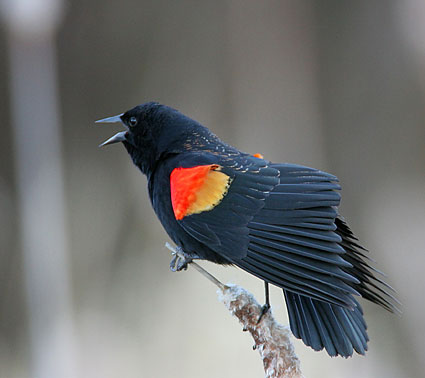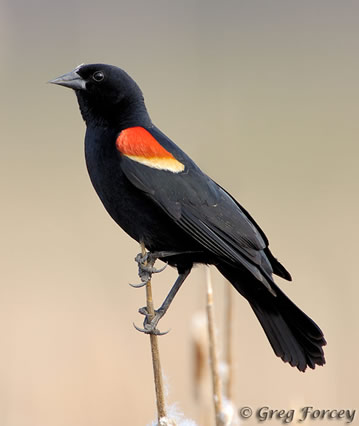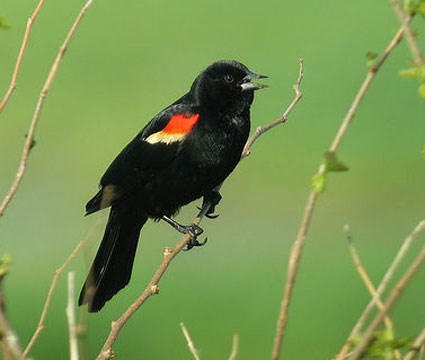
Agelaius phoeniceus
TAXONOMY
Oriolus phoeniceus Linnaeus, 1766, Charleston, South Carolina.
Presently, 20 geographically discrete forms are recognized.
OTHER COMMON NAMES
English: Cuban red-winged blackbird; French: Carouges а
йpaulettes; German: Rotschulterstдrling; Spanish: Tordo Alirrojo,
Tordo Capitбn, Mayito de la Diйnaga, Sargento.
PHYSICAL CHARACTERISTICS
7–9.5 in (18–24 cm); female 1–1.9 oz (29–55 g), male 1.9–2.9
oz (53–81 g). Sexually dimorphic in color. Males black with red
epaulets edged with a yellow bar. Young males are dark brown
and heavily streaked below with some red in the wing. Males
in their second year resemble older males, but many of their
feathers are edged with brown. Females are streaked with dark
brown. Juveniles resemble females.
DISTRIBUTION
Breeds from eastern Alaska and Great Bear Lake, east to James
Bay, southern Quebec, and southwestern Newfoundland, south
to Costa Rica; local in Central America, and absent as a
breeder from western Mexico and central and southern Baja
California. Winters from southern Canada south to Costa
Rica, including western Mexico and Baja California.
HABITAT
Marshes and rank, moist thickets.
BEHAVIOR
Territorial during the breeding season. Males defend a territory
with songs and chasing. In winter, found in flocks, often
enormous ones that contain several different species of blackbirds
as well as European starlings (Sturnus vulgaris).
FEEDING ECOLOGY AND DIET
Forage low in vegetation or on the ground.
REPRODUCTIVE BIOLOGY
Males are commonly simultaneously paired to several females.
Females build the nest, which is a bulky cup of woven vegetation,
commonly woven to several stalks of emergent vegetation
in marshes. Clutch size is smaller in the south than in
the north and ranges in size from 4 to 5 eggs, which are laid
from May to mid-June. Incubation 11–13 days; fledging at
about 11–12 days. Usually single brooded, but replacement
clutches may be produced.
CONSERVATION STATUS
Not threatened. One of the most abundant North American
birds.
SIGNIFICANCE TO HUMANS
Considered an agricultural pest in many areas. Much effort and
money have been expended in attempts to control blackbird
roosts, and consequently humans are one of the major causes
of adult mortality.
Photo Gallery of - Red-winged blackbird




 Animalia Life
Animalia Life